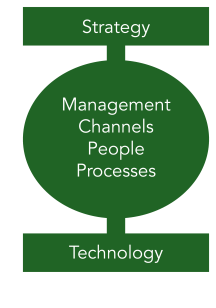
The Fi growth methodology has 6 pillars: 2 business enablers (strategy, technology) and 4 business cycles (management, channels, people, processes). Each pillar has a catalog with all the activities a company needs to be able to grow sustainably and a knowledge base with global best practices in each activity. The Fi growth methodology is client-centered and omni-channel, being an antidote to commoditization.

Strategy is a business enabler that contains the definitions of the growth strategy components: what is the company's culture, what offers to sell to which clients, through which direct and intermediated channels (physical and digital), with what prices and with what distinctive brands.

Management is a business cycle that is repeated annually in the pursuit of growth: making the sales and marketing plans, budgeting revenues and costs, monitoring and analyzing performance, communicating internally and externally, celebrating successes, management results, making adjustments and learning from experience.

Chanels is a business cycle that is repeated annually in the pursuit of growth: making the territorial plan to dimension each channel, establishing distribution contracts with intermediaries or building physical and digital means for direct channels, enabling them to sell, setting annual sales targets, monitoring and supporting the intermediaries’ activity, remunerating according to results, reviewing the category of each intermediary according to its evolution and learning from experience.

People is a business cycle that is repeated annually in the pursuit of growth: making the territorial plan to dimension the sales team (global and for each channel), recruiting, training and setting objectives for each person, coaching continuously, compensating according to results, promoting and learning from experience.

Processes is a business cycle that is repeated continuously in the pursuit of growth: planning in detail the marketing and sales campaigns of each channel, planning how to communicate with clients, carrying out communication campaigns to captivate clients, welcoming clients and selecting sales opportunities, persuading clients to buy, negotiating and closing sales, retaining clients and learning from experience.

Technology is a business enabler that contains the resources needed to carry out the activities of the business cycles: operational systems for employees, clients and partners, reporting systems, analytic and predictive systems and productivity tools.
